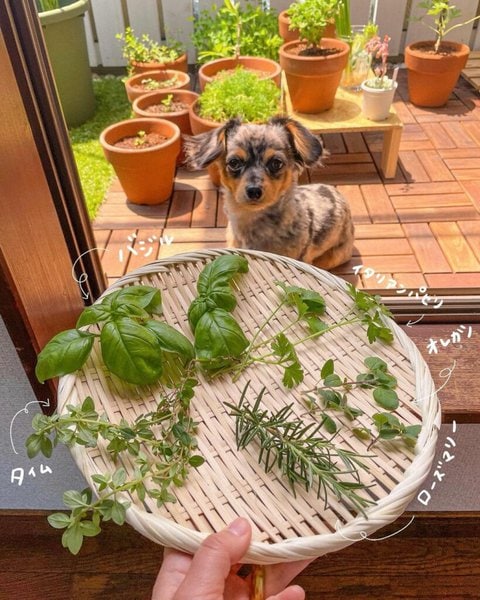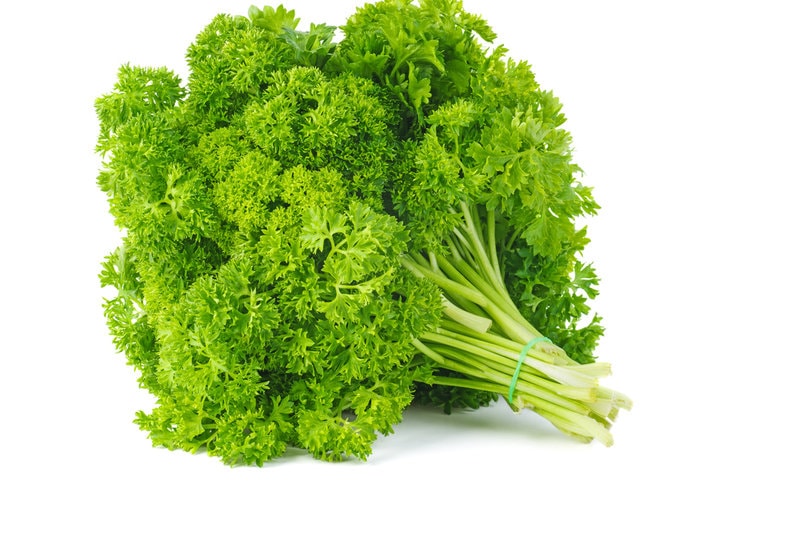You may have to search long and wide to find someone who doesn’t love parsley. The herb is a favorite among Americans, Europeans, and countries in the Middle East due to the aroma it adds to cuisines. Since our canine buddies love to share in our meals, is it safe to let them have parsley?
Yes, dogs can have parsley in small quantities, but it must be only the safe variety – curly parsley. Parley packs several beneficial nutrients to dogs, such as vitamins A, C, and K, and minerals like calcium, magnesium, iron, and phosphorus.
However, you’ll need to be cautious about feeding parsley to your furry friend to avoid some health complications. In this article, we’ll examine the effects of parsley on your dog and how you can safely let them have some of this herb.
What Happens If My Dog Eats Parsley?

Your dog will greatly benefit from the nutrients found in the safe type of parsley when consumed in moderation but will risk suffering several health complications by feeding on other varieties.
When dogs eat non-toxic parsley or the curly variant, there are several benefits they could get from it. Parsley is a natural source of vitamins A, C, and K. These vitamins help enhance vision, build immunity, and facilitate healthy blood clotting. Parsley also has folic acids and antioxidants that help promote kidney and urinary health.
However, other varieties of parsley contain some toxins, such as apiol and myristicin, the same chemical that make nutmeg notorious to pets. Apiol can cause abortion in pregnant dogs.
Meanwhile, myristicin may cause dry mouth, stomach upset, abdominal pain, or disorientation in canines. More severe reactions to myristicin include hallucinations, increased heart rate, high blood pressure, difficulty breathing, and convulsions.
Why Does My Dog Like Parsley?
Dogs like parsley because of its fresh mild herbal aroma.
Dogs’ curiosity is often piqued by scents, and parsley is aromatic. That makes it the perfect herb for curious dogs to sniff at and eventually nibble. If you have a parsley garden, you would want to keep the gates locked to keep your furry friend away from munching them.
Does Parsley Freshen Dog’s Breath?
Yes, parsley freshens your dog’s breath.
Parsley contains some aromatic oils which can help freshen your dogs’ breath. Also, chlorophyll in parsley is a potent antibacterial, which can deal with the odor-causing bacteria in your dog’s mouth. Unsurprisingly, some mouthwashes for dogs contain extracts from parsley.
How Much Parsley Can I Give My Dog?
The weight and size of your dog determine the quantity of parsley they can have. A teaspoon of non-toxic parsley is okay for every 20 lbs of weight. This amount means that small dogs, such as Chihuahuas and Poodles, can have only a teaspoon. Large dogs can have two or, at most, three.
Also, parsley should only feature occasionally in your four-legged friend’s diet. Most importantly, you should watch your Fido after feeding it parsley for any reactions.
Can Parsley Be Toxic?

Yes, most species of parsley can be toxic to dogs.
Except for curly-leaf parsley, other varieties contain toxins that, in high doses, can be detrimental to your furry canine’s health. Some of these toxins include apiol, myristicin, xantotoxin, and bergapten.
Consequently, eating parsley could negatively affect your dog, causing blindness, pregnancy complications, and kidney problems.
May Cause Blindness
Some species of parsley, namely, spring parsley, flat-leaf parsley, and Italian parsley, can contain high amounts of furanocoumarins. Furanocoumarins are photosensitive compounds that, in the presence of ultraviolet rays in sunlight, can lead to eye lesions, clouding of the cornea, and eventually blindness.
May Cause Dermal Problems
The presence of photosensitive chemicals in parsley, such as bergapten, furanocoumarins, and xantotoxin, may cause skin problems in dogs when exposed to the sun’s UV rays. These photosensitive toxins absorb UV rays which cause them to start chemical reactions. The most common side effects of this occurrence include skin blistering and peeling.
May Lead To Kidney Problems
Parsleys generally have high fiber content and diuretic properties. Dogs prone to kidney problems can exacerbate their condition if they take any variety of parsley in large quantities.
Adversely Affects Pregnant Dogs
Parsley contains a toxin, apiol, which can lead to complications in pregnant dogs. A possible side effect of this toxin is early contractions, which may lead to the abortion of the canine’s fetus.
What Kind Of Parsley Can Dogs Eat?
Dogs can only eat one type of parsley, and that’s curly parsley.
All other varieties are unsafe for dogs because they contain toxins that may cause serious health problems to dogs. You should avoid including them in your dog’s diet, no matter how small the quantity.
Is Flat-Leaf Parsley Good For Dogs?
No, flat-leaf parsley is not good for dogs.
Flat-leaf parsley contains high amounts of furanocoumarins, a type of phototoxic chemical. An animal study reveals that the phototoxic action of this chemical is its ability to be activated in sunlight to react with nuclear bases in your furry friend’s DNA.
Possible outcomes of eating furanocoumarins-rich flat parsley include blistering and peeling of the skin and corneal damage that can lead to blindness.

Is Mint And Parsley Good For Dogs?
Yes, both fresh mint and parsley are good for dogs in moderate quantities.
Both mint and parsley can provide your furry friend with fresh breath, loads of essential vitamins, and other nutrients. Even then, mints and parsley should only be served to your dog occasionally and in small quantities. However, unlike parsley, most species of mint are safe for dogs except the English pennyroyal. This mint species is toxic to dogs and could cause mint poisoning.
Can Dogs Eat Raw Parsley?
Yes, dogs can eat raw parsley if you wash them properly.
You can slice fresh parsley into tiny pieces and add it to Fido’s food. Doing this will let them benefit from the nutrients without losing part of it to heat.
Again, fresh parsley is a well-known therapy for bad breath. If your dog has a stinky mouth, munching a few leaves of raw parsley to help them deal with bad breath. Parsley contains chlorophyll which has a natural deodorizing effect when chewed. Besides, chlorophyll can also fight bacteria in your furry friend’s mouth and digestive system.
Can I Put Parsley In Homemade Dog Food?
Yes, you can add a healthy variety of parsley (curly parsley) to your dog’s homemade food.
Your canine friend may not favor eating parsley if you serve it alone. Mixing tiny shreds of parsley with your dog’s food is an effective way to feed the herb to your dog.

Can My Dog Eat Parsley Stems?
Yes, your large dog can eat parsley stems, but you must cut them into tiny bits to prevent them from sticking to your dog’s throat.
Parsley stem, like the leaves, contains beneficial nutrients for dogs. However, abstain if your doggy is a toy breed to reduce the chances of choking. Parsley stems may also be too tough for these small dog breeds to chew well and digest properly, causing some digestive problems.





